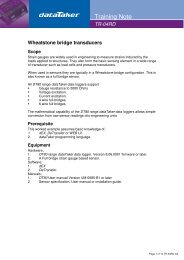You also want an ePaper? Increase the reach of your titles
YUMPU automatically turns print PDFs into web optimized ePapers that Google loves.
Examples<br />
GPS "GPGLL" 1 D 5000<br />
Receive NMEA-0183 "GPGLL" sentences. Every 5 seconds, return the current degrees component (-37 for the above input<br />
data)<br />
GPS "GPGSV" 3<br />
When polled, return the number of satellites in view (the third field in a "GPGSV" sentence).<br />
FORMAT Sub-command<br />
As indicated above, all slot definition commands that return a data value may include a FORMAT clause to specify how the<br />
data value should be formatted – otherwise the data will be returned in raw hexadecimal form. The format of a FORMAT<br />
sub-command is as follows:<br />
FORMAT { rawFormat } { scale offset } { "formatString" } { stats }<br />
where:<br />
rawFormat specifies how the raw bit field is to be interpreted. It consists of two letters, one being U or S (unsigned or<br />
2's complement signed; default: U), the other M or N (Motorola (MSB first) or Intel (LSB first); default: M). Note that for<br />
J1939 memory slots (RECVJ, RQSTJ), Intel format is always used. The byte swapping options are ignored if the size<br />
of the data field is not a multiple of 8 bits.<br />
scale is a floating point scaling factor which will be multiplied by the raw bit field value (default: 1.0).<br />
offset is a floating point offset which will be added to the scaled bit field value (default: 0.0).<br />
<br />
<br />
formatString is a string which specifies: the output type (raw hexadecimal, integer, floating point, string, etc.),<br />
formatting options (eg. number of decimal places) and any leading or trailing text. Default is "%f\n" (output floating<br />
point value, 2 decimal places, followed by CRLF) See below for more details.<br />
stats is a statistical operation (MIN, MAX or AVE). If set, all matching CAN messages are received and processed.<br />
When the slot is polled, the calculated minimum, maximum or average value (since last poll) is returned. If not<br />
specified (which is the default), the most recent instantaneous data value is returned. Note: statistical operations are<br />
only valid for passive CAN slot types (RECV, RECVE, RECVJ)<br />
Format String<br />
A format string consists of three text elements:<br />
some text to display before the data value (default: none)<br />
a conversion specifier, which begins with a % character and specifies the data type (integer, floating point etc.) and<br />
possibly some other formatting details. If no conversion specifier is present (which is the default), the data value will be<br />
output in raw hexadecimal format, exactly as it appears in the CAN message (in this case the rawFormat, scale, offset<br />
and stats parameters will be ignored.)<br />
some text to display after the data value (default: \n). If no conversion specifier is present, all text in the format string<br />
will be returned after the data value.<br />
The format of the conversion specifier is as follows (there are no gaps between the various elements):<br />
% { flag } { width }{ .precision } type<br />
where:<br />
% marks the start of the conversion specifier<br />
<br />
<br />
<br />
<br />
type is a single character which specifies the data type: f (floating point), d (signed decimal integer), u (unsigned<br />
decimal integer), x/X (unsigned lower/upper case hexadecimal integer) or s (ASCII string)<br />
flag is a single character which alters the way the other elements work, as described in width below (default: none)<br />
width is an integer, the minimum number of characters to output. If the converted data value is longer than width then<br />
all characters will still be output. If the data value is shorter then it will be padded on the left with spaces (or zeroes, if<br />
flag = '0') so that a total of width characters are output. If flag = '-' then the data value will instead be padded on the<br />
right with spaces if it is shorter than width. The default value for width is 0, ie. no padding characters will be inserted.<br />
precision is an integer which specifies different things depending on the data type. For floating point, it is the number of<br />
digits displayed to the right of the decimal point (default: 2). For integers, it is the minimum number of displayed digits;<br />
if the data value has fewer digits it will be prefixed by zeroes (default: 0). For strings, it is the maximum number of<br />
characters to display, If the data string is longer then it will be truncated (default: no maximum).<br />
Note that following points about format strings:<br />
<br />
<br />
An integer (d/u/x/X) or floating point (f) conversion specifier will be ignored if the data field is larger than 32 bits. In<br />
this case the value will be returned in raw hexadecimal format.<br />
Integer or floating point conversion specifiers are ignored for GPS slots. For a GPS slot, all data values are treated as<br />
strings.<br />
UM-0086-A2 <strong>CANgate</strong> User’s <strong>Manual</strong> Page 21



